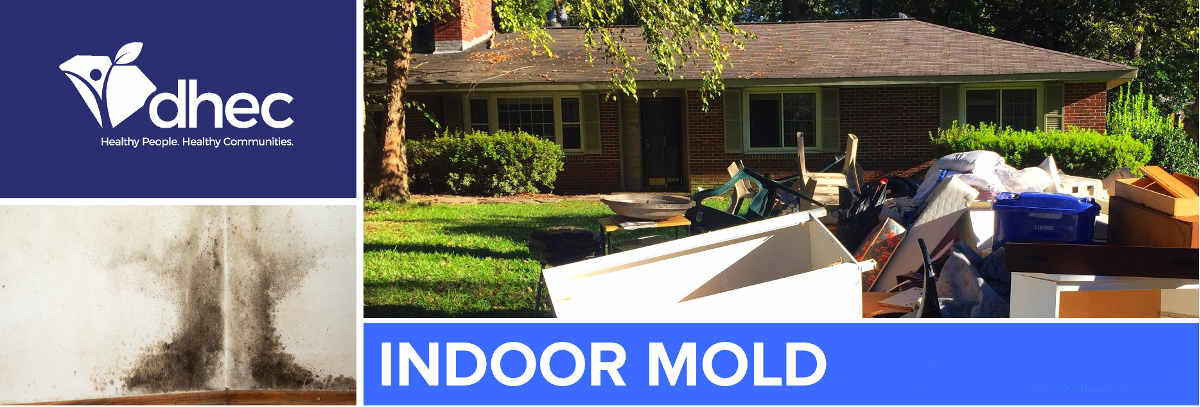Indoor Mold After a Weather Event - Fact Sheet (pdf)
Many South Carolina residents are concerned about indoor mold as a result of severe weather disasters. As part of our commitment to assist those who have been affected, DHEC has compiled the following information to guide decisions regarding mold in homes and workplaces.
If you're experiencing any issues with flooding, below is an important resource number to be aware of.
- Mold Hotline: 888-815-3509 for general information.
Presence of Mold after a Severe Weather Event:
- Excess moisture and standing water contribute to the growth of mold in homes and other buildings.
- Steps can be taken to prevent mold growth if wet items are cleaned and dried within 24 to 48 hours. Make sure you only enter your home once it is safe.
Signs of Mold:
- Mold can be recognized by sight or smell or present no signs at all (hidden behind walls or under floors)
- Sight (Mold growth often appears on walls and ceilings, looks like spots and can be many different colors)
- Smell (You may smell a strong unpleasant musty, earthy odor)
People at Greatest Risk for Health Effects from Mold:
- If you are allergic to mold, or you have asthma, allergies, or other breathing conditions, being around mold may make your condition worse.
- If you have a chronic lung condition or a weak immune system (such as people with HIV infection, cancer patients taking chemotherapy, and people who have received an organ transplant), you could be more susceptible to mold infections in your lungs.
Possible Health Effects of Mold Exposure:
- People who are sensitive to mold may have a stuffy nose, irritated eyes, wheezing, or skin irritation.
- People who are allergic to mold may have difficulty breathing or have shortness of breath.
- People with weakened immune systems or chronic lung diseases may develop mold infections in their lungs.
- If you or your family members have health problems after exposure to mold and you think that mold is affecting your health, please contact your doctor or other health care provider.
Cleaning Wet or Moldy Items after a Severe Weather Event:
- When your home is safe to enter, dry out your home as quickly as possible to minimize mold problems and perhaps even prevent the growth of mold at all.
- Water damage specialists or mold remediation companies have experience with cleanups of flooded homes and can provide you the peace of mind of knowing mold problems will be properly taken care of. At a minimum, a maintenance or service professional that is experienced in mold clean up should check and clean your home heating, ventilating and air-conditioning (HVAC) system before you turn it on. If the HVAC system was flooded with water, turning on the system may spread mold throughout the house.
- If you choose to perform clean up yourself, the U.S. Environmental Protection Agency (EPA) offers the following information:
- To protect yourself from potential exposure to mold, buy an N-95 or N-100 mask at your local home supply store and wear it while cleaning your home (an ordinary dust mask or handkerchief will not protect you from the mold)
- Hard-surfaced, non-porous items which do not absorb water can be cleaned using soap and water and disinfected with a bleach solution of no more than 1/2 cup of bleach in 1 gallon of water. (Never mix bleach with other household cleaners. Mixing bleach and ammonia can produce dangerous toxic fumes ). Nonporous materials include tile floors, countertops, showers, tubs, metal objects, plastic, glass, and other hard nonabsorbent materials and surfaces.
- Porous materials soak up water like a sponge. Items that cannot be dried thoroughly within 24-48 hours of getting wet are much more difficult to disinfect and may need to be replaced to prevent mold growth. Porous items include wood, drywall, carpet, mattresses, fabrics, and furniture made of particle board.
- Ensure that wood studs are completely dry prior to re-installing wallboard. If the wood is not completely dry, more mold can start growing behind the new wallboard.
- Use plastic to shield areas adjacent to where you are working so that spores disturbed by the clean-up don't become reattached to a new substrate and grow. This includes sealing off nearby HVAC ducts, which often have sources of moisture and food for spores to grow.
Additional Information and Resources:
- Mold Hotline: 888-815-3509 or local: 803-898-9387.
- Visit the Centers for Disease Control & Prevention's websites about Mold After a Disaster and Floods.
- Visit the U.S. Environmental Protection Agency's Mold website or download EPA's Brief Guide to Mold, Moisture and Your Home.
- Visit the U.S. Environmental Protection Agency's website on Mold in Schools and Commercial Buildings or download EPA's Building Air Quality Guide.
- Find volunteer organizations in your area that may provide mold remediation services for victims visiting the SC Emergency Management Division's volunteer website or by contacting the United Way at 2-1-1 or http://www.sc211.org. [If you are experienced in mold remediation and are interested in volunteering your services, please visit the SC Emergency Management Division's volunteer website or call 1-843-212-0552.]
- Consult a Professional Mold Remediation company (check the Yellow Pages under Mold or Water Damage Restoration).
Because there are no state or federal laws, regulations, or standards for mold or indoor air quality, DHEC cannot test, monitor or inspect for mold or indoor air quality in homes or public buildings.
